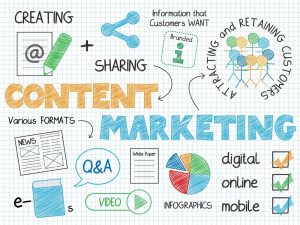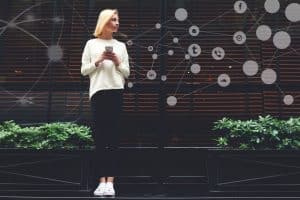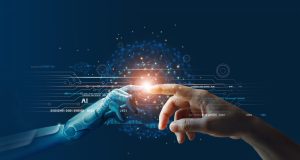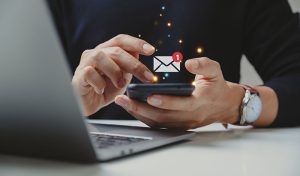Artificial intelligence (AI) has become an increasingly popular tool. It’s even been used in online marketing in recent years, with many businesses using AI-generated content and artwork to improve their marketing strategies. AI-generated artwork is created by algorithms that analyze data and generate images based on specific criteria, such as color, shape, and style.
Artificial Intelligence (AI) generated artwork refers to computer-generated images, animations, videos, and music created using algorithms and machine learning. This technology has revolutionized how artists and marketers create and promote online content. AI-generated artwork can be a game-changer for online marketing, helping businesses create engaging and visually appealing content that resonates with their target audience.
This article explores the benefits of AI-generated art for online marketing and some potential negative effects.
Part 1: The Benefits of AI-generated Artwork for Online Marketing
1 – Efficiency
One of the most significant advantages of AI-generated artwork is its efficiency. With AI, marketers can create and generate artwork much faster than traditional methods. AI algorithms can process large amounts of data and create complex designs quickly and accurately. This speed and accuracy can help businesses save time and money, as they can create and distribute their content faster and more efficiently.
2 – Customization
AI-generated art can be customized to fit a business’s unique needs and preferences. For example, AI algorithms can analyze data and generate artwork that aligns with a business’s branding, values, and messaging. This customization can help businesses stand out from their competitors and create content that resonates with their target audience.
3 – Creative Possibilities
AI-generated artwork opens up a whole new world of creative possibilities for businesses. With AI, businesses can create artwork that would be impossible or difficult to create using traditional methods. For example, AI-generated art will have complex patterns, textures, and visually stunning and attention-grabbing designs.
4 – Scalability
Another benefit of AI-generated artwork is its scalability. With AI, businesses can create artwork that can be used across multiple channels and platforms, including social media, email marketing, and website design. This scalability can help businesses save time and money, as they can create one piece of artwork for many platforms.
5 – Data-Driven Insights
AI-generated artwork can provide businesses with valuable data-driven insights into their target audience’s preferences and behaviors. Businesses can better understand what types of artwork resonate with their target audience by analyzing click-through rates, engagement rates, and conversion rates. This data can then create more effective marketing campaigns and content.
Part 2: The Negative Effects of AI-generated Artwork for Online Marketing
1 – Lack of Originality
One of the potential negative effects of AI-generated artwork is the lack of originality. AI art generator algorithms are designed to analyze and replicate patterns and designs, which can result in artwork that lacks uniqueness and creativity. This lack of originality can make it difficult for businesses to stand out from their competitors and create artwork that resonates with their target audience.
2 – Dependency on Technology
Another potential negative effect of AI-generated artwork is the dependency on technology. Businesses that rely on AI-generated artwork may find themselves at a disadvantage if the technology fails or becomes outdated. This dependency can also limit creativity and prevent businesses from exploring new and innovative ways to create and promote their content.
3 – Lack of Human Touch
AI-generated art can lack the human touch that traditional artwork possesses. The human touch refers to the emotions, creativity, and personal expression artists bring to their work. While AI can create visually stunning artwork, it may not have the same emotional impact or connection with the audience as artwork created by humans.
4 – Overreliance on Metrics
AI-generated artwork can lead to an overreliance on metrics and data-driven insights. While data can provide valuable insights into a business’s target audience, it may not always reflect the emotional impact or effectiveness of artwork. This overreliance on metrics can limit creativity and prevent businesses from exploring new and innovative ways to create and promote their content.
5 –Ethical Concerns
AI-generated artwork raises ethical concerns related to intellectual property and ownership. While AI algorithms are programmed to create original artwork, it is often difficult to determine the source of the inspiration or original idea. This can lead to disputes over ownership and copyright infringement. Additionally, there are concerns about the ethical use of AI-generated artwork for advertising and marketing purposes, especially if it is used to manipulate or deceive the audience.
AI-generated artwork has the potential to be a game-changer for online marketing. It can provide businesses with a more efficient, customized, and creative way to create and promote their content. However, it is important to consider the potential negative effects of AI-generated artwork, such as the lack of originality, dependency on technology, and ethical concerns. Ultimately, businesses should strive to find a balance between the benefits and drawbacks of AI-generated artwork and use it in a responsible and ethical way.
How do you avoid letting AI-generated artwork negatively affect your online marketing campaign?
To avoid the negative effects of AI-generated artwork in your online marketing campaign, consider the following:
- Balance automation and human creativity: While AI-generated artwork may be more efficient, it is important to balance automation with human ingenuity to ensure that your artwork is original and resonates with your target audience. Consider incorporating human input, such as design feedback, to add a personal touch to your artwork.
- Emphasize creativity and originality: To stand out from your competitors and avoid the lack of originality associated with AI-generated artwork, prioritize creativity and originality in your artwork. Encourage your designers to think outside the box and experiment with different styles and techniques.
- Prioritize quality over quantity: While AI can create artwork rapidly, it is important to prioritize quality over quantity. Focus on creating high-quality, visually appealing artwork that resonates with your target audience rather than creating a large volume of mediocre artwork.
- Stay up-to-date with technology: To avoid dependency on technology, stay up-to-date with the latest advancements in AI and design software. This will allow you to use AI to its full potential while also maintaining the flexibility to adapt to new technology in the future.
- Use AI ethically: To avoid ethical concerns related to AI-generated artwork, use AI-generated art ethically and responsibly. Be transparent about using an AI art generator in your marketing campaign and ensure your artwork is not misleading or manipulative.
By incorporating these strategies, you can ensure that your online marketing campaign benefits from the efficiency and creativity of AI-generated artwork while avoiding the potential negative effects.
You may now be wondering why it is important to incorporate A.I.-generated content and artwork into your online marketing campaigns. Here are some of the main reasons why it is a great idea.
There are several reasons why it is important to incorporate AI-generated content and artwork into your marketing strategy:
- Increased Efficiency: AI can generate content and artwork faster and more efficiently than humans. This can save time and resources, allowing your marketing team to focus on other aspects of your campaign.
- Personalization: AI can analyze data about your target audience and personalize your content and artwork accordingly. This can increase the effectiveness of your marketing campaign by creating content that resonates with your audience on a deeper level.
- Creativity: AI-generated artwork can be more creative and innovative than traditional artwork. This can help your brand stand out from competitors and capture your audience’s attention.
- Consistency: AI-generated content and artwork can ensure consistency in your branding and messaging. This is particularly important for businesses with multiple locations or a large online presence.
- Cost-effectiveness: AI-generated content and artwork can be more cost-effective than traditional methods. This can help businesses with limited marketing budgets to create high-quality content and artwork without breaking the bank.
Incorporating AI-generated content and artwork into your marketing strategy can help you achieve your marketing goals more efficiently while providing a competitive advantage. By leveraging the power of AI, businesses can create content and artwork that is personalized, creative, and consistent while also saving time and resources.
What is the best way to introduce AI content and artwork into your marketing efforts?
- Identify your goals: Determine what you want to achieve through AI-generated artwork. This could be increasing engagement, improving conversion rates, or building brand awareness.
- Research AI software: Research and compare AI software tools that can generate artwork, such as Adobe Sensei, Canva, and Designhill. Consider the features, pricing, and compatibility with your existing marketing software.
- Develop a plan: Develop a plan for how you will incorporate AI-generated artwork into your marketing strategy. This should include how often you will create new artwork, what types of artwork you will make, and how you will integrate it with your existing marketing channels.
- Train your team: Train your marketing team on using AI art generator software and incorporating AI-generated artwork into your marketing strategy. This will ensure everyone is on the same page and can use the software effectively.
- Test and refine: Test your AI-generated artwork and refine your strategy based on the results. This may involve A/B testing different types of artwork or analyzing engagement metrics to see what resonates with your target audience.
By following these steps, you can effectively incorporate AI-generated artwork into your online marketing strategy and start reaping the benefits of this innovative technology.
So what are the best AI-generating tools for artwork?
There are several AI-generating tools available for creating artwork. Some of the most popular ones are:
- DeepDream: Developed by Google, DeepDream uses a deep learning algorithm to generate surreal and abstract images from existing photos.
- Prisma: Prisma is an app that uses neural networks to transform photos into art. It offers a wide range of filters and styles inspired by famous artists such as Van Gogh and Picasso.
- Runway: Runway is a platform that allows users to create and experiment with AI-generated artwork. It offers a range of tools and algorithms for creating everything from images and videos to 3D models.
- ArtBreeder: ArtBreeder is an online tool that allows users to mix and match different images to create new and unique art pieces. It uses a combination of machine learning and genetic algorithms to generate new images.
- Adobe Sensei: Adobe Sensei is a suite of AI-powered tools that allow designers to create more efficiently and effectively. It includes features such as auto-tagging, image recognition, and content-aware fill, making it easier for designers to create and manipulate images.
These tools offer a range of features and capabilities, and businesses can choose the one that best suits their needs and preferences.
Here are some interesting facts about AI-generated artwork that you might find surprising:
- AI can create artwork in various styles: AI algorithms can create artwork in a wide range of styles, from realistic to abstract, depending on the input data and the desired output. Businesses can use AI to create artwork tailored to their brand and target audience.
- AI-generated artwork is becoming more realistic: With the use of deep learning algorithms, AI-generated artwork is becoming more and more realistic. This means that it can be difficult to distinguish between AI-generated artwork and artwork created by human artists.
- AI can generate artwork in real-time: Some AI algorithms can generate artwork in real-time, allowing businesses to create dynamic and interactive content for their audiences.
- AI can learn from existing artwork: AI algorithms can analyze existing artwork and learn from it to create new and unique pieces. This means businesses can use AI to create artwork inspired by existing pieces but with a unique twist.
- AI-generated artwork can be used for a variety of purposes: AI-generated artwork can be used for many things, from creating custom graphics for social media to generating images for use in advertising campaigns. As AI technology continues to improve, the possibilities for its use in creating artwork are endless.
What are some frequently asked questions about AI-generated artwork, and what are the answers?
Can AI-generated artwork be considered “real” art?
Answer: The debate around whether AI-generated artwork can be considered “real” art is ongoing. While some argue that AI is simply a tool artists use to create artwork, others argue that AI-generated artwork lacks the emotional depth and intentionality of human-made art.
Can AI-generated artwork be copyrighted?
Answer: No, AI-generated artwork cannot be copyrighted. Copyright laws only apply to human-created things.
Can AI-generated artwork replace human artists?
Answer: While AI-generated artwork can create visually appealing images and even mimic human styles, AI-generated artwork is unlikely to fully replace human artists. Art is an expression of human creativity and emotion, and while AI-generated artwork can be impressive, it may lack the emotional depth and uniqueness of human-made art.
Can AI-generated artwork be used for commercial purposes?
Answer: Yes, AI-generated artwork can be used for commercial purposes, such as advertising, branding, and marketing. However, it is important to ensure that the artwork does not infringe on copyright or intellectual property rights.
How can AI-generated artwork be integrated into marketing strategies?
Answer: AI-generated artwork can be integrated into marketing strategies in a variety of ways, such as creating custom graphics for social media, generating images for use in advertising campaigns, and creating interactive and personalized content for audiences. It can help businesses stand out from their competitors and engage with their audiences in new and exciting ways.
Now you know what AI-generated artwork can do for your marketing campaign, are you ready to make the jump?
Get More Out of Your Marketing – Choose Revity
Are you looking to create content that connects with your target audience but needs help figuring out where to start? Revity can help.
Our team of experts at Revity can assist you in developing a marketing strategy that helps your business achieve its goals. Whether you need help creating content or want help with your whole marketing plan, Revity has the expertise and tools to drive growth for your business.
Contact us today, and let’s talk about how we can take your marketing to the next level.
































